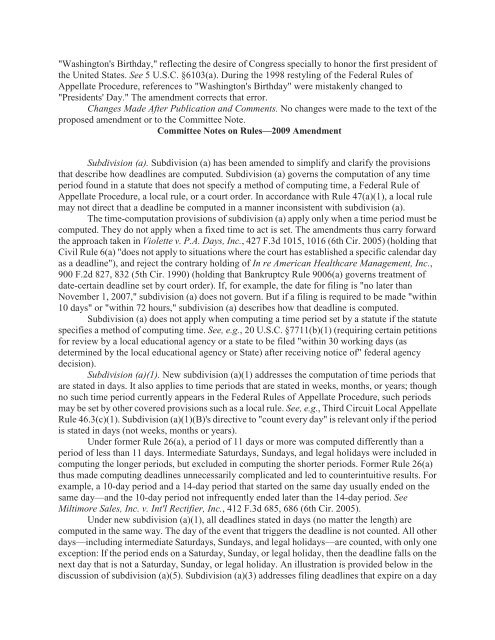Federal Rules of Appellate Procedure 2014-2015, 2014a
Federal Rules of Appellate Procedure 2014-2015, 2014a
Federal Rules of Appellate Procedure 2014-2015, 2014a
You also want an ePaper? Increase the reach of your titles
YUMPU automatically turns print PDFs into web optimized ePapers that Google loves.
"Washington's Birthday," reflecting the desire <strong>of</strong> Congress specially to honor the first president <strong>of</strong><br />
the United States. See 5 U.S.C. §6103(a). During the 1998 restyling <strong>of</strong> the <strong>Federal</strong> <strong>Rules</strong> <strong>of</strong><br />
<strong>Appellate</strong> <strong>Procedure</strong>, references to "Washington's Birthday" were mistakenly changed to<br />
"Presidents' Day." The amendment corrects that error.<br />
Changes Made After Publication and Comments. No changes were made to the text <strong>of</strong> the<br />
proposed amendment or to the Committee Note.<br />
Committee Notes on <strong>Rules</strong>—2009 Amendment<br />
Subdivision (a). Subdivision (a) has been amended to simplify and clarify the provisions<br />
that describe how deadlines are computed. Subdivision (a) governs the computation <strong>of</strong> any time<br />
period found in a statute that does not specify a method <strong>of</strong> computing time, a <strong>Federal</strong> Rule <strong>of</strong><br />
<strong>Appellate</strong> <strong>Procedure</strong>, a local rule, or a court order. In accordance with Rule 47(a)(1), a local rule<br />
may not direct that a deadline be computed in a manner inconsistent with subdivision (a).<br />
The time-computation provisions <strong>of</strong> subdivision (a) apply only when a time period must be<br />
computed. They do not apply when a fixed time to act is set. The amendments thus carry forward<br />
the approach taken in Violette v. P.A. Days, Inc., 427 F.3d 1015, 1016 (6th Cir. 2005) (holding that<br />
Civil Rule 6(a) "does not apply to situations where the court has established a specific calendar day<br />
as a deadline"), and reject the contrary holding <strong>of</strong> In re American Healthcare Management, Inc.,<br />
900 F.2d 827, 832 (5th Cir. 1990) (holding that Bankruptcy Rule 9006(a) governs treatment <strong>of</strong><br />
date-certain deadline set by court order). If, for example, the date for filing is "no later than<br />
November 1, 2007," subdivision (a) does not govern. But if a filing is required to be made "within<br />
10 days" or "within 72 hours," subdivision (a) describes how that deadline is computed.<br />
Subdivision (a) does not apply when computing a time period set by a statute if the statute<br />
specifies a method <strong>of</strong> computing time. See, e.g., 20 U.S.C. §7711(b)(1) (requiring certain petitions<br />
for review by a local educational agency or a state to be filed "within 30 working days (as<br />
determined by the local educational agency or State) after receiving notice <strong>of</strong>" federal agency<br />
decision).<br />
Subdivision (a)(1). New subdivision (a)(1) addresses the computation <strong>of</strong> time periods that<br />
are stated in days. It also applies to time periods that are stated in weeks, months, or years; though<br />
no such time period currently appears in the <strong>Federal</strong> <strong>Rules</strong> <strong>of</strong> <strong>Appellate</strong> <strong>Procedure</strong>, such periods<br />
may be set by other covered provisions such as a local rule. See, e.g., Third Circuit Local <strong>Appellate</strong><br />
Rule 46.3(c)(1). Subdivision (a)(1)(B)'s directive to "count every day" is relevant only if the period<br />
is stated in days (not weeks, months or years).<br />
Under former Rule 26(a), a period <strong>of</strong> 11 days or more was computed differently than a<br />
period <strong>of</strong> less than 11 days. Intermediate Saturdays, Sundays, and legal holidays were included in<br />
computing the longer periods, but excluded in computing the shorter periods. Former Rule 26(a)<br />
thus made computing deadlines unnecessarily complicated and led to counterintuitive results. For<br />
example, a 10-day period and a 14-day period that started on the same day usually ended on the<br />
same day—and the 10-day period not infrequently ended later than the 14-day period. See<br />
Miltimore Sales, Inc. v. Int'l Rectifier, Inc., 412 F.3d 685, 686 (6th Cir. 2005).<br />
Under new subdivision (a)(1), all deadlines stated in days (no matter the length) are<br />
computed in the same way. The day <strong>of</strong> the event that triggers the deadline is not counted. All other<br />
days—including intermediate Saturdays, Sundays, and legal holidays—are counted, with only one<br />
exception: If the period ends on a Saturday, Sunday, or legal holiday, then the deadline falls on the<br />
next day that is not a Saturday, Sunday, or legal holiday. An illustration is provided below in the<br />
discussion <strong>of</strong> subdivision (a)(5). Subdivision (a)(3) addresses filing deadlines that expire on a day


















